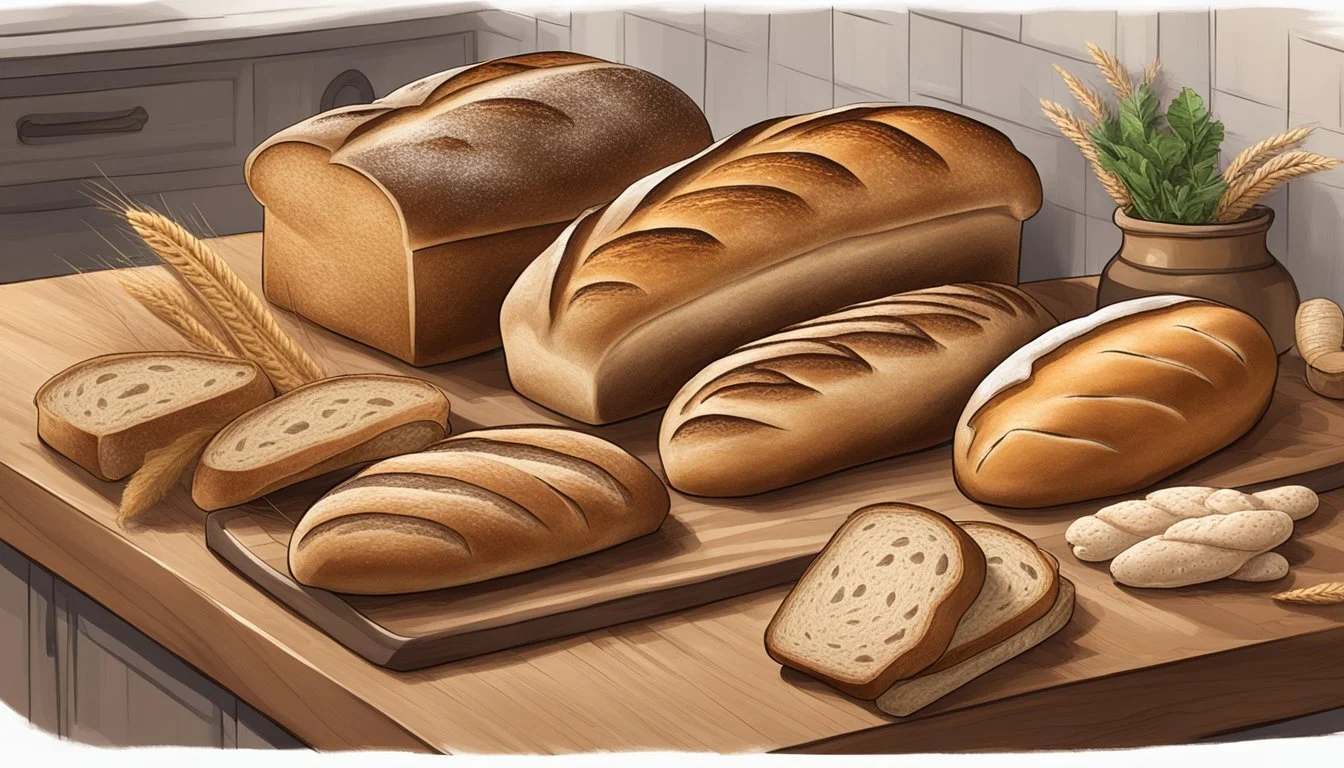Ciabatta Bread Substitutes
Top Alternatives for Your Recipes
Ciabatta bread, a staple of Italian cuisine, is beloved for its distinctive chewy texture and porous, airy crumb. This rustic bread has found its way into a variety of dishes, from traditional sandwiches (What wine goes well with sandwiches?) to avant-garde culinary creations. Its versatility and unique texture make it a desired component in the kitchen. However, there are times when ciabatta is unavailable, prompting the need for suitable alternatives.
Substitutes for ciabatta bread should ideally mimic its texture and flavor profile to maintain the integrity of the dishes it complements. Sourdough bread, renowned for its tangy flavor and substantial chew, stands as a close substitute. It offers a slightly denser crumb but still delivers a robust and satisfying eating experience. Other alternatives explore different textures and flavors, such as the ciriola Romana, which is crispy on the outside and chewy on the inside, with a similar ingredient list to ciabatta.
When exploring alternatives to ciabatta, it's important to consider the dish they will be used in. The chosen substitute should not only satisfy the structural needs—as in the case of sandwich making—but should also harmonize with the flavor palette of the accompanying ingredients. Whether for a sandwich, croutons, or simply to enjoy with a spread, there is an array of breads available that can step in when ciabatta is not on hand.
Understanding Ciabatta Bread
Ciabatta bread is a staple of Italian cuisine, known for its distinctive texture and flavor. The discussion below delves into its rich history, essential ingredients, and meticulous production process.
History and Characteristics
Ciabatta bread originated in Italy as a response to the popularity of French baguettes. Its name, meaning "slipper" in Italian, aptly describes the bread's flat, elongated shape. Characteristic features of ciabatta include:
Airy texture: Large holes punctuate its interior.
Chewy texture: The exterior is typically crusty and robust.
Hydration level: High water content is crucial for its unique crumb structure.
The flavor of ciabatta is mildly sour, akin to sourdough bread, owing to the fermentation process.
Key Ingredients
The key to authentic ciabatta bread lies in its simple yet precise ingredients:
Flour: High protein content strengthens the dough.
Water: Higher levels of hydration compared to most bread.
Yeast: Contributes to the development of the airy texture.
Salt: Balances the flavors and regulates yeast activity.
Olive oil: Occasionally added for a subtle flavor and to keep the dough tender.
Production Process
The process to create ciabatta involves careful consideration of both ingredients and technique:
Creating the Dough: Mixing flour, water, yeast, and salt to form the dough. Hydration ratios typically approach 5:4 flour to water.
Kneading: Develops the gluten network essential for trapping gases during fermentation.
Fermentation: The dough ferments, allowing yeast to produce gas, contributing to the airy texture.
Shaping: Gently forming the dough into its characteristic slipper shape to preserve air pockets.
Baking: A hot oven bakes the dough until the crust is golden and the interior is well-structured with an open crumb.
Patience and precision in the production process are indispensable for capturing the essence of this beloved Italian bread.
Choosing Substitutes for Ciabatta
When selecting a substitute for ciabatta bread, the key points one should focus on are the textural qualities and flavor profile, making sure that the alternative complements the dish as effectively as the original.
Criteria for Selection
Selecting an appropriate substitute involves examining several critical characteristics:
Texture: Ciabatta has a distinctive soft exterior and chewy interior. Substitutes should mimic this texture to ensure they work well, especially in sandwiches and paninis.
Flavor: A robust flavor that echoes ciabatta’s mild tanginess can be an asset.
Versatility: The substitute should be as adaptable as ciabatta, functioning well across various culinary applications.
Table 1: Substitute Comparison
Substitute Texture Flavor Versatility French Baguette Crusty exterior Mild High Sourdough Crisp crust, moist Tangy High Focaccia Soft and oil-infused Herb-infused Moderate to High No-Knead Bread Crusty and moist Neutral to Mild High
Health Considerations
For those searching for a healthier alternative, the following aspects are important:
Fiber Content: Higher fiber options can provide a healthier alternative to traditional ciabatta.
Carbohydrate Levels: Substitutes that offer lower carbohydrate content can be beneficial for those monitoring their carbohydrate intake.
When the goal is to choose a healthier option, it's crucial to compare the nutritional content of potential substitutes to that of ciabatta bread.
Table 2: Nutritional Comparison (per 100g)
Substitute Fiber (g) Carbohydrates (g) French Baguette Low High Sourdough Moderate Moderate Focaccia Low High No-Knead Bread Moderate Moderate to High
One may opt for substitutes like whole grain variations of these breads to boost fiber content and potentially create a more balanced nutritional profile.
Popular Ciabatta Alternatives
When looking for a substitute for ciabatta bread, consider factors such as texture, flavor, and the bread's purpose. The alternatives listed here are renowned for their unique characteristics and can complement dishes typically served with ciabatta.
Sourdough Bread
Sourdough bread is well-known for its distinctive tangy flavor and a chewy crumb that comes from its longer fermentation process. This bread's versatility makes it suitable for a variety of dishes, from classic sandwiches to hearty toast.
French Baguette
French Baguette, another crusty contender, has a crisp exterior and a soft interior. Its shape and size offer convenience for slicing and creating perfect sandwich servings. Moreover, the baguette is known for its mild flavor, which makes it a go-to for those who want a subtly-flavored bread.
Focaccia Bread
For a more flavor-infused option, Focaccia bread, with its olive oil-rich composition, makes for a delightful alternative. Often dotted with herbs and seasoned toppings, focaccia brings a Mediterranean flair that pairs well with a variety of toppings.
Whole Wheat Breads
Offering a healthier twist, whole wheat breads, including those made from atta or other varieties of wheat flour, provide a nutritious alternative with a heartier texture. These breads have a robust flavor profile and are an excellent option for those seeking whole grain benefits.
Specific Uses of Alternatives
When seeking substitutes for ciabatta bread, it's important to consider the bread's texture and flavor profile as it pertains to its use in various dishes. Chewy textures, crispy crusts, and unique flavors can impact the final preparation of the intended meal.
Sandwiches and Paninis
For sandwiches and paninis, a bread that can withstand grilling or pressing without falling apart is essential. Sourdough bread, with its robust structure and tangy taste, fits the bill perfectly. It also contributes a chewy texture to the meal, enhancing the overall eating experience. Alternatively, a French baguette provides a crispy crust that offers a delightful contrast to the soft fillings.
Soups and Salads
Complementing soups and salads, breads serve both as an accompaniment and an ingredient, such as in croutons. Sourdough is a good choice for croutons due to its firm texture that remains resilient in broths and dressings. Bagels, sliced and toasted, can provide a similarly satisfying chewiness and are versatile enough to pair with a range of flavors in soups and salads.
Bruschetta and Pizza
When preparing bruschetta, a bread with a firm surface is preferable to hold the weight of the toppings. Focaccia shares similar olive oil flavors with ciabatta, and its dimpled surface is ideal for capturing the juices and seasonings. As a base for pizza, focaccia's thicker body provides a sturdy foundation for a variety of toppings, ensuring a satisfying bite that combines a soft interior with a lightly crisp exterior.
Recipes and Preparation Tips
When substituting ciabatta with other types of bread, one must consider recipe adaptations, optimal baking techniques, and creative serving suggestions to maintain the dish's integrity and flavor.
Adapting Recipes for Substitutes
In any recipe originally calling for ciabatta, one should alter hydration levels and prep time when using substitutes. For instance, French baguettes, while crusty, have a tighter crumb than ciabatta and may require more moisture. Sourdough, with its distinct tangy flavor, serves as a starter replacement, impacting the fermentation period and flavor profile. Each substitute will involve a specific mixture of ingredients and preparation steps to mimic ciabatta's characteristics such as its open crumb and chewy texture.
Baking Techniques
Shaping dough resembles an art form; each bread type calls for its unique technique. While ciabatta is often referred to as a "slipper" due to its flat, elongated shape, substitutes like bagels demand precise shaping and boiling before baking. Employing tools like a bench scraper or baking stone can substantially impact the final product. When preparing dough, it should be carefully transferred onto a baking sheet lined with parchment paper or cornmeal to prevent sticking. Monitoring cook time is crucial since, unlike ciabatta, some substitutes might bake more quickly due to varying size and thickness.
Serving Suggestions
Presentation often enhances the dining experience. Sliced French baguettes present an elegant side to hearty soups, while a sourdough boule, with its crisp crust and soft interior, complements rich spreads and cheeses. For servings, it's essential to adjust slice thickness according to the bread's texture and the meal's context. Furthermore, noting the calories can help maintain nutritional balance, especially when substituting brioche, which has a higher butter content and therefore more calories than ciabatta.
Pairing with Other Foods
When selecting a ciabatta bread substitute for culinary creations, the focus is on complementing the unique flavor profiles of accompanying foods. Cheeses and dressings are pivotal elements that can elevate a dish into a delectable culinary adventure.
Complementary Cheeses
Pairing the right cheese with bread substitutes can accentuate the taste experience. With a French Baguette, a classic contender due to its crustiness, one might consider Brie or Camembert for their creamy textures that contrast nicely with the crunch. When using a dense alternative like a Bagel, one might opt for sharp Cheddar or Gruyère to counter the chewiness with their bold flavors.
Focaccia: Known for its olive oil infusion, pairs splendidly with:
Italian Mozzarella
Sourdough: With its tangy note, is harmonious with:
Swiss varieties
Aged Gouda
Dressings and Vinegars
Selecting the appropriate dressing or vinegar can enhance the bread's character and create a harmonious blend with other meal components. Balsamic vinegar, with its sweet and tangy profile, works beautifully with rustic bread choices, adding a sophisticated touch to salads and sandwiches. When using a robust bread like No-Knead Bread, simple vinaigrettes made from balsamic can highlight the bread's effortless taste and texture.
Olive Oil: An all-time classic, pure or with herbs, complements virtually any bread substitute.
Red Wine Vinegar: Adds a zesty kick to sandwiches made with Bagel or Ciabatta alternatives.
Substitutes in Different Cuisines
When seeking alternatives to ciabatta in various cultural culinary practices, it is essential to consider how each substitute complements the dish's original flavors and textures, matching the ciabatta's rustic appearance and chewy texture.
Cuban Bread as a Substitute
Cuban bread is a viable substitution in sandwiches, particularly the Cuban sandwich, which requires a bread that is crusty on the outside and tender on the inside. Although not Italian, it is a suitable substitute for Cuban bread due to its similar texture profile to ciabatta.
Italian-style Alternatives
Focaccia bread, hailing from the Italian culinary tradition, serves as a flavorful alternative with its olive oil-infused crust and soft interior. This bread shares the fermentation process which gives ciabatta its distinctive taste, making focaccia a versatile option for dishes requiring Italian bread.
French-inspired Options
The French baguette, recognized for its crispy crust and light interior, is an excellent stand-in for ciabatta. A baguette's rustic appearance and elongated shape closely mirror the qualities of ciabatta, making it a fitting choice in recipes that traditionally use Italian bread.







